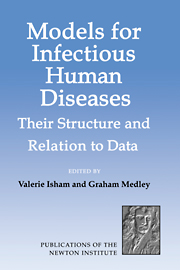Book contents
- Frontmatter
- Contents
- Introduction
- Participants
- Non-Participant Contributors
- Part 1 Transmissible diseases with long development times and vaccination strategies
- Part 2 Dynamics of immunity (development of disease within individuals)
- Part 3 Population heterogeneity (mixing)
- Part 4 Consequences of treatment interventions
- Part 5 Prediction
Introduction
Published online by Cambridge University Press: 04 August 2010
- Frontmatter
- Contents
- Introduction
- Participants
- Non-Participant Contributors
- Part 1 Transmissible diseases with long development times and vaccination strategies
- Part 2 Dynamics of immunity (development of disease within individuals)
- Part 3 Population heterogeneity (mixing)
- Part 4 Consequences of treatment interventions
- Part 5 Prediction
Summary
The epidemiology of infectious human diseases
Understanding and controlling the spread of infections is of vital importance to society, and in the past century the epidemiology of human disease has become a subject in its own right. Theory and applicable techniques have been developed to study both the evolution of disease within individual people and the transmission of infections through populations. Mathematics has an important role to play in these studies, which raise challenging problems ranging from broad theoretical issues to specific practical ones, and in recent years there have been significant advances in developing and analysing mathematical models of disease progression. For example, in human diseases in particular, the problems of modelling population heterogeneity are especially important.
Over the last decade there has been a great deal of work concerned with HIV and AIDS. This has been concentrated mainly in two areas: the statistical estimation of various parameters associated with HIV infection (for example, the probability of vertical transmission; the description of the incubation period from infection to clinical disease; the estimation from reported AIDS cases of the number of people infected), and the description of transmission of HIV within and between populations (for example, the characterisation of networks of risk behaviour; the impact of different control strategies). To an extent, the growth of studies in this area has become divorced from the study of other infections, and therefore one of the primary purposes of this volume is to bring together work on modelling a wide range of human diseases so as to encourage cross-fertilisation between AIDS related research and research of the epidemiology of other infections.
- Type
- Chapter
- Information
- Models for Infectious Human DiseasesTheir Structure and Relation to Data, pp. xi - xivPublisher: Cambridge University PressPrint publication year: 1996
- 1
- Cited by

